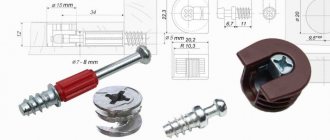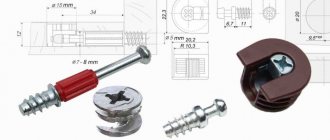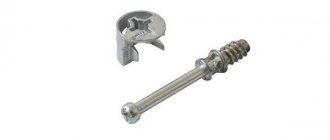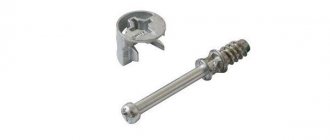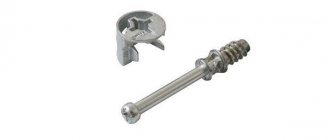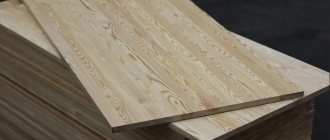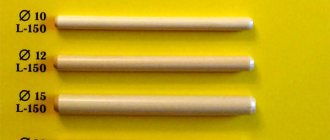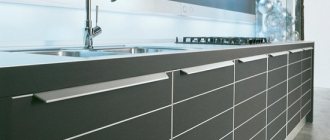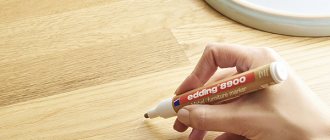The characteristics of the materials used in furniture production imply the use of a variety of fastening fittings. Its range is very extensive, and high-quality assembly is impossible without fasteners that match the specific task. The furniture screw is the most popular representative of connecting elements in the production of upholstered and cabinet furniture. Its popularity is due to its wide range of applications, reliable fixation, ease of installation and moderate cost.
How to drill a hole for placing a confirmat
The confirmat is screwed into a previously prepared hole, so the question of how to drill such a hole is quite relevant. To do this you will need the following tools and materials:
- screwdriver or electric drill;
- bit of the appropriate size;
- drill for confirmation;
- a measuring tool, which can be a ruler (or a construction tape);
- pencil;
- awl.
To facilitate marking and maintain a strictly perpendicular position of the drill, use a template for drilling holes for confirmat
Hole dimensions for Euroscrew
For furniture assembly, Euro screws are usually used, the dimensions of which are 6.4x50 mm. To make holes for such a confirmat, the outer thread diameter of which is 6.4 mm, and the cross-sectional size of the screw body is 4.4 mm, a drill with a diameter of 4.5–5 mm is used. Drilling holes for confirmation of this type should be performed to a depth of at least 50 mm. If the diameter of the hole is larger than the specified value, then the Euroscrew simply will not hold; if it is smaller, it can tear the furniture element into which it is screwed.
The step drill is selected based on the dimensions of the specific Euroscrew model
The drill used to make holes for the confirmation must be equipped with a special working head. On the one hand, she prepares an expanded hole for the neck of the screw, on the other hand, she countersinks the place where the screw head will be placed. To place the confirmat, you can also use a regular drill, but in this case it is necessary to prepare places for the neck of the fastener and its head.
Marking drilling locations
The reliability and quality of connections made using confirmats largely depend on the accuracy of marking future holes for them. On the element that will overlap the end of another element of the furniture structure, two types of markings are made:
- drilling depth (5–10 cm);
- the center of the future hole (if the thickness of the joining part is 16 mm, it should be at a distance of 8 mm from the edge of the slab).
Drilling diagram for Euro screws
To mark the drilling locations as accurately as possible, you can use the following simple technique: after preliminary marking, a through hole is made in the applied part, through which, by attaching the first part to the second, a rotating drill is used to mark the location of the second hole for the European screw.
Making holes
In order to make the holes for placing confirmations as efficiently as possible, it is advisable to follow the recommendations below.
- Before drilling a part, you need to place a piece of unnecessary chipboard under it: this will prevent chips from appearing at the exit of the hole being created.
- The formation of places for the neck and cap of the confirmat in an already made hole can be done by holding the workpiece in weight.
- When drilling both in the layer of the part and at its end, the drill is positioned strictly perpendicularly. This will allow you to get a high-quality result and not damage the part.
- When drilling two parts simultaneously, they must be securely fixed in the required position, for which you can use clamps and other clamping devices. This is the most accurate and fastest way to create confirmation holes.
- When drilling holes for dowels, it is advisable to equip the tool used with a depth limiter, which will prevent damage to the workpiece by drilling through them.
Head types
The most common types of heads are:
- Spherical flat. They have a large area of contact with the material, so they allow you to strongly tighten any parts. They are designed for a straight screwdriver.
- Spherical for hexagon. They can withstand high force during tightening, so that the fastened parts are connected securely and tightly. Screws with such heads are tightened using a hex key.
- Flat for Phillips screwdriver. Allows you to create collapsible connections inside and outside furniture. The conical head of the screw is immersed in the material at the same level with it, so it looks aesthetically pleasing. Tighten with a Phillips screwdriver or a screwdriver with a Phillips bit.
- Secret. To install screws of this type, it is necessary to prepare a seat for them in the workpiece in advance. To do this, a hole is drilled in it and a chamfer is made, with the help of which the fastener head is hidden in the chipboard.
Spherical flat Hexagon
For Phillips screwdriver Countersunk
Peculiarities
Furniture fasteners are designed to connect furniture elements. The use of this product helps reduce production costs, because complicated types of fasteners (tenon and groove or so-called dovetail) will cost more. Furniture screws will also allow you to forget about adhesive fastening of furniture parts. This means that the wardrobe or bed can be disassembled, for example, for moving, but when fixed with glue this is virtually impossible.
But a screw fastening, if it suddenly remains unclaimed for its original purpose, can also be useful in solving other problems. And we’re not even talking about homemade shelves on the wall, where such fasteners are logical. In construction, in the country, in the garage, furniture screws can also be useful.
Installation Rules
Many who come across confirmations for the first time have a logical question regarding which holes to drill for the Euroscrew being used and how this procedure is generally performed.
There shouldn’t be any problems with how to drill holes if you have previously worked with a drill and understand the principle of its operation.
Before installing the confirmation in the furniture body, it is necessary to make the appropriate markings. To apply it you will need a jig or a template. With their help, you can significantly speed up the work and also achieve a high level of accuracy. If you are doing simple markings, you will not need a jig (template).
For proper installation of the confirmat, it is recommended to find out in advance about the material of the furniture itself, as well as about the design features of the euroscrew. A total of 3 holes are needed:
A drill of the appropriate diameter is used for each hole. It is the time required to create several holes that makes you spend much more time assembling furniture.
But there is a solution. It is presented in the form of a special drill, which is intended specifically for confirmations. Finding it in Leroy Merlin or in any other furniture fittings store will not be difficult. The peculiarity of a special drill is that it allows you to prepare 3 different holes simultaneously in one go. This is due to the design of the drill itself.
Drilling and installation
We will step by step consider the procedure for drilling a hole and then installing a confirmat into it.
To assemble furniture using Euroscrews, you need to prepare special holes. The process involves performing the following steps:
- First, a hole is drilled for the tie (confirmation). Drills with a diameter of 4 to 7 millimeters are often used here;
- Thanks to a stepped cutter or just a special drill for confirmation, the procedure can be significantly simplified;
- The cutter is fixed on the drill. This makes it possible to correctly form a hole in two components simultaneously;
- For the threaded part of the confirmation, the diameter should be 5 millimeters, and the diameter of the hole for the head itself is already 7 millimeters;
- On the first furniture element, a hole is made of the through type, since the smooth part of the special head and the cap itself will be located there;
- In the second part, a blind hole is made, where an internal thread is formed by drilling the threaded part of the Euroscrew in the end part;
- To ensure the most accurate connection, furniture elements can be fixed using machines, furniture vices and other devices. This prevents possible shifts.
When drilling, try to use a drill or screwdriver that can rotate at the highest possible adjustable speed. This will ensure the creation of the most accurate, even and high-quality holes.
It is difficult to imagine assembling modern cabinet furniture without the use of confirmats. This is the most modern type of hardware, which can significantly speed up and simplify the furniture assembly process.
The use of confirmats allows you to avoid corners, self-tapping screws and other fasteners, which do not have the most attractive appearance, and are also inferior to the Euroscrew in terms of reliability.
Confirmation is not just a fad or fashion. This is a truly universal and effective solution in furniture production. And we are fortunate in many ways that we now have the opportunity to assemble furniture using such fasteners.
What do you think about confirmations and have you ever worked with them? Who assembled ready-made furniture and used such fastenings? And who had to make the holes for the confirmation themselves? Share your experience and your opinion.
Thanks everyone for your attention! Subscribe, leave comments and ask relevant questions!
Watch this video on YouTube
Varieties
Use options depend on the purpose and design of the specific fastener. Next, we will look at the most common types of furniture screws and how to use them.
Euroscrew (confirmed)
Structurally, it is a cylindrical part with a countersunk head, in which there are slots for a hexagon or Phillips screwdriver. Directly behind the countersunk head is a smooth part, which should fit smoothly into the workpiece being pressed. The size of the smooth part varies and depends on the purpose of the particular screw. For example, the standard thickness of laminated chipboard (chipboard) is 16 mm. To properly attach one sheet of chipboard or a material of the same thickness, it is enough to use fasteners whose smooth part is 16 mm. For these tasks, furniture screws with a diameter of 7 mm and a length of 50-60 mm are most often used.
The application technology involves drilling workpieces. This is due to the characteristics of the material that is most often used in the furniture industry (chipboard). The thickness of the confirmat does not allow it to be screwed into a chipboard without drilling. The drill used in the process of preparing parts for joining has a special configuration and varies in diameter in different areas.
Theoretically, you can drill with three different drills:
- The largest radius is intended to make a countersunk under the head of the confirmat; in fact, this part of the tool does not make a hole, but only chamfers.
- Next, a hole is made in the workpiece being pressed; its diameter is equal to the smooth part of the Euroscrew (for example, 7mm).
- The thinnest hole is drilled into the part to which the previous one is pressed; its diameter is 5 mm.
It is not very convenient to work with three drills: you need to change them or have three drills in which the required diameter will be set. In addition, making a countersunk by hand with a drill is quite difficult. Taking these factors into account, one special drill was developed, which is used by modern furniture makers. When the preparatory work is completed, the workpieces are tightened together with screws. The tool for twisting the latter is selected depending on the design of the cap.
If the most popular confirmation size is 7x50 mm, then the most common spline configuration is a hexagon. The following tools are used to tighten hex screws:
- Hex bit, for use in a screwdriver, drill or screwdriver;
- L-shaped or Z-shaped hex key;
In addition to hex splines, there are also Phillips splines, but their use does not allow the parts to be tightened tightly enough, which leads to rapid loosening of the finished product.
Screw tie
It consists of two elements: a screw with an external thread and a barrel-nut with an internal one. During the joining process, the parts are positioned perpendicular to each other, that is, one workpiece with its flat side is pressed against the end of the other workpiece. A through hole is drilled in the pressed part, the diameter of which is slightly larger than the threaded part of the screw. In the workpiece to which the previous one is pressed, two holes are drilled: one at the end with the same diameter as in the part being pressed; the other on the flat side is for the barrel. The difficulty lies in the exact alignment of the end hole and the hole for the barrel.
Like the Euroscrew, the main use of this fastener is furniture production. By using a screw tie, you can achieve significant structural rigidity, which is not available when using any fasteners without metric threads, for example, confirmations or self-tapping screws.
The disadvantages of this connecting material are that it is difficult to install, requiring certain skills, and that the head of the furniture screw is visible from the outside. The last drawback can be partially hidden using special plugs, but this does not solve the problem completely.
Conical tie (mini-fix)
To install a conical tie, you do not need to drill through the part, which is attached with the flat side. The functioning mechanism is somewhat similar to a screw tie. The difference is in the fixation of the rod: it is attached not to a through hole, but to the flat part of the workpiece being clamped (after pre-drilling). The parts are fastened together by pressing the rod with a tie screw. This type of connecting elements is often used to attach a tabletop to a base or during the assembly of frame-type furniture facades.
Conical ties are also not easy to install; they require precise marking and drilling, which requires a highly qualified assembler. In addition, silumin used to manufacture the tension screw has a short service life, which significantly reduces the number of assembly/disassembly cycles of the finished product. In most situations, such a joint turns out to be disposable; in any case, for reassembly, the silumin tension screw will have to be replaced.
Shelf holders with fixation
This type of fastener is designed to hold shelves in furniture products. Its peculiarity is that, in parallel with its main purpose (support for shelves), it provides additional structural rigidity. The shelf holder consists of two parts: a rod and a support mechanism. The rod is screwed into the cabinet wall, and the support mechanism is installed directly into the shelf. During the assembly process, the rod must fit into the hook of the eccentric mechanism. After this, the shelf is attracted to the cabinet walls by turning the eccentric screw in the shelf holder.
This type of fittings is also not easy to install; it requires specialist skills and special equipment. In addition to marking and drilling, installation will require milling, which is best done in a workshop on a drilling machine.
Intersectional screed
Designed for connecting individual furniture modules. Essentially, it’s a bolt and nut, only in a more aesthetic design. The part of the tie that acts as a nut is made in the form of a hollow bolt (bushing) with an internal thread into which a movable tension element is screwed. During the assembly process, it is the screw (an element with an external thread) that needs to be tightened, and not the bushing, since it has slots that prevent it from turning in the laminated chipboard wall.
Quite easy to use and reliable, a furniture screw, usually made of high-quality metal, provides a rigid connection of individual sections in furniture production. Often used during the assembly of kitchen units, in particular wall cabinets. An intersectional screed turns individual cabinets into a solid monolithic wall, eliminating the occurrence of differences between kitchen units during operation.
Furniture screw with round or decorative head
Classic threaded connections are used for upholstered and cabinet furniture. There are several varieties of this fastener, the main distinguishing features of which are the design of the head and fixing elements. The screw is fixed in the particle board using a square headrest or slots. Such fasteners are quite convenient to use, since the nut can be screwed on without resorting to additional fixation of the screw itself. There are also options designed to be held with a screwdriver or hexagon.
Furniture screws are distinguished by size, material of manufacture and type of head. Let's take a closer look at each of the above types.
Semicircular
Decorative
To size
- The furniture screed is produced in accordance with the most commonly used material, that is, laminated chipboard, the thickness of which is 16 mm. Considering that the screed connects two plates drilled through, the length of one is 32 mm. This is the most popular size, but there are also 50mm length options;
- Euroscrew comes in thicknesses of 5, 6.3 and 7 mm. Moreover, its length can be 40, 50, 60 and 70 mm. Lengths of 60 and 70 mm are found only on 7 mm confirmats;
- The dimensions of the conical tie are standard: total length 44 mm diameter 6 mm;
- The length of the screw tie is 34 mm, while the diameter of the barrel is 10 mm, and the screw itself is 8 mm;
- The length and diameter of screws with a semicircular or flat head can be different and depend on the type of fixing element. For example, hexagon screws come with a diameter of 6 or 8 mm, length from 16 to 110. The maximum length of furniture bolts for a screwdriver or with a square headrest is 150 mm, while the standard diameter is 6 and 8 mm.
According to the material of manufacture
The purpose of this type of fastening materials is to fix furniture structures of varying degrees of rigidity. In addition, the finished product should look no worse than that of competitors. To achieve the optimal balance between the solidity of the structure and its appearance, the following materials are used:
- Metal fasteners made using carbon steel grades;
- Aluminum and its alloys (silumin) - used in screw elements of complex configuration, for example, a mini-fix lag screw;
- Brass is a more aesthetic and practical material. Used on visible areas of structures or in places with high humidity;
- Plastic is used as a body material in the seats of some types of ties, such as the shelf holder body;
Metal fasteners for furniture can be coated or uncoated (most often galvanized), but in any case, the products are regulated by GOST or other standards.
Based on the type of head, there are the following types of furniture screw heads:
- Spherical flat head without internal splines for retention with external locking tool. Typically, such fasteners have a square headrest or a fixing mustache. Basically all furniture screws are DIN 607;
- Spherical head for hex, flat or Phillips screwdriver. The most common representative of this type of fastener is a screw with a press washer DIN 967;
- Flat head for a Phillips or hex screwdriver, for example, a screw that complies with DIN7420 regulations;
- Countersunk head for a hexagon or Phillips bit (confirmations and some types of threaded fasteners).
Steel Aluminum Brass
Coatings used
Furniture fastening fittings are used in the vast majority of cases indoors, which protects them from the harmful influences of the environment. However, all metal elements made of steel subject to corrosion are subject to special treatment:
- Galvanizing gives metal fasteners higher functional and decorative qualities. In most cases it is a white, matte finish, less often – with a golden tint;
- Galvanic brass plating. Unlike galvanizing, this coating provides a more attractive appearance, which is achieved by adding copper to the coating alloy.
The above technologies for applying zinc and copper alloys to fasteners are designed to provide higher performance and decorative qualities. Screw elements made of aluminum are almost never coated with protective compounds, due to the properties of the material from which they are made.
Galvanized
Brass
Manufacturing materials
Furniture screws must have certain characteristics (strength, resistance to moisture) and an attractive appearance. They are made from various materials. The most common:
- Carbon steel. The products are durable, but do not look very attractive, so they are coated with zinc or brass, which also increases corrosion resistance.
- Aluminum and its alloys. Fasteners made from these materials are used in complex structures. For example, such a product is a minifix lag screw. Elements made of silumin have a short service life, so they are used less often.
- Brass. It is considered the most attractive and practical alloy. Used on visible areas of furniture and in places with high humidity levels.
- Plastic. Used for the manufacture of housings for some elements of landing ties, for example, a shelf holder or a barrel of a screw retainer.
All furniture fasteners are mainly used indoors, so the influence of the environment (rain, temperature changes) is minimal. Still, many try to use stainless elements.
Carbon steel
Aluminum Brass Plastic
Scope of application
As the name suggests, the main purpose of this fastener is furniture production. Naturally, the application is not limited to this, and screw fastening is used in many sectors of the national economy, as well as for solving everyday problems. Depending on the size and design, the following options for using this fastener can be distinguished:
- Connecting laminated chipboard panels during the assembly of cabinet furniture;
- Assembly of frames in the process of manufacturing beds, sofas, armchairs and other upholstered furniture;
- Interfacing of solid wood parts in carpentry and construction.
Some types of screws have a rather narrow scope of application. For example, locking shelf supports are designed solely to hold shelves. At the same time, not a single closet or bedside table can do without fasteners such as confirmat. And the use of bolts, in addition to their main purpose, is widespread in areas quite far from the furniture industry.
What is a self-tapping screw and its purpose
A self-tapping screw is a special type of metal screw; in relation to wood, such a fastener is an element with a wider pitch of turns and a flat or sharp end.
Self-tapping screws are a popular type of fastener that has its own undeniable advantages.
In furniture stores you can find connecting elements with straight, Phillips or hex heads. To screw them in, you will need screwdrivers with the appropriate type of bits.
It is important to select fasteners based on the material and its density, thickness, etc.
Areas of application
Tabletops and sectional walls, cabinet and sofa parts, tables, chests of drawers and children's sets - this is the main area of demand for furniture screws. They are made primarily for assembling furniture, for holding hinges and fittings, for attaching handles and the like.
This fastener allows you to:
- join sheets of chipboard;
- assemble furniture frames;
- fix bulky wood elements.
There are fasteners that cannot perform more than one task. So, it’s unlikely that shelf supports can be used anywhere else (well, unless the master’s creativity finds another area of application for them).
Since today the uniqueness of interior design of housing, simplicity of solutions, and the introduction of vintage elements, Soviet designs and home-made furniture into the interior are actively developed and supported, screws will help bring these ideas to a reasonable implementation.
Dimensions
In this sense, it is easier to focus on the table when choosing screws. There are columns such as M4, M5, M6, M8, M6x30, various parameters like 8x35 and others. M is the thread indicator; the table below shows the minimum and maximum values for this indicator, as well as the nominal dimensions.
If you don't want to look at the table, here are a couple of examples:
- the conical tie is universal in size - 44 mm length and 6 mm diameter;
- confirmation thickness is 5, 6.3 and 7 mm, and length is from 40 to 70 mm;
- screw tie length – 34 mm, barrel diameter 10 mm, screw part diameter – 8 mm;
- furniture fastenings with a square headrest reach a maximum length of 150 mm, diameter - 6 or 8 mm.
In construction markets, furniture fasteners are sold in a separate block, where all options and standard sizes are divided into sections. The consultant will help you navigate the assortment.
Shelf supports
There are a huge number of types of shelf supports. However, they can be divided into two groups: shelf holders for chipboards and shelf holders for glass. In turn, each of these groups can be divided into two types: shelf holders with and without fixation.
The shelf holder for chipboard consists of 2 parts: a rod and a shelf holder.
Increase
Fig. 14.
The screw is installed in the cabinet wall, and the shelf holder is installed in the body of the shelf. To install the shelf holder, you need to drill holes in the shelf and cabinet wall. For most shelf supports, the hole sizes are standardized; they are shown in the figure below. However, when installing the shelf support, you should carefully read the instructions to avoid errors.
Increase
Fig. 15.
It should be noted that shelf holders for chipboard come with or without fixation. The shelf holder with fixation has an eccentric mechanism, thanks to which the shelf will be firmly connected to the cabinet wall. Shelf supports with fixation have one more advantage; shelf supports of this type serve as additional reinforcement of the furniture structure.
Increase
Fig. 16.
Glass shelf holders have a simpler design. They are attached only to the cabinet walls using a self-tapping screw.
Increase
Fig. 17.
Shelf holders for glass without fixation are a rod or an angle. Shelf holders with fixation have a special screw with which the glass is firmly fixed and cannot accidentally fall out.
Increase
Fig. 18.
Types of fasteners
Screws can be of different types depending on what they are intended for. They differ in shape, types of heads, materials of manufacture, and sizes. In addition, all screws have a different installation method.
Confirmat
This type of fastening screws is in great demand in the furniture industry. Confirmats allow you to connect various parts made of chipboard and MDF panels with each other. They have a large rod and threaded surface, so the load on the material being fastened is small.
Before tightening the screws, you must first make holes for them with a confirmation drill. A screwdriver or screwdriver is used for fixing. In this case, removable nozzles or bits are selected depending on the type of slot.
Advantages of confirmations:
- tightly tighten almost any parts;
- it is convenient to work with them;
- allow the structure to withstand heavy loads for a long time.
Flaws:
- not suitable for regular assembly/disassembly of furniture - each time the fastened elements are fixed less and less well;
- need to be masked using plastic plugs, which must be matched to the color of the product.
Screw tie
This type is used when it is necessary to fasten the end of one element to the surface of another. The coupler consists of a screw and a cylindrical iron barrel, in which a threaded channel is provided. Sometimes plastic varieties are installed in furniture, with a nut inside.
Types of furniture casters, their design features
To install fasteners, a hole is drilled on the surface on one panel, and on the end of the second part. In the first, a barrel is installed so that the channel in it is aligned with the hole in the end element. After which a bolt is placed there and screwed into the barrel with a screwdriver or screwdriver. Thanks to the large thread stroke, this mount is considered very reliable and durable. The disadvantage of a screw tie is the visibility of the head.
Intersectional screed
Consists of a screw and nut (hollow bolt or sleeve) that allow two perpendicular elements to be fastened. Basically, these fasteners are made of high-quality metal, so they reliably and rigidly connect furniture sections together. The screw is screwed into a sleeve, which is fixed using slots in plywood or chipboard. Thanks to this, individual cabinets turn into a single structure. For precise installation of the intersection screed, clamps are used, which tightly press the upright parallel sections of furniture walls together. In this case, the screws are tightened with a Phillips screwdriver.
An intersection screed is selected taking into account the thickness of chipboard or other material.
Conical coupler
It is considered an improved type of screw fastener. To hide the bolt head from the front side, use a rod that is screwed into the flat part of the clamped part (after drilling the holes). This reduces the tightening stroke, so this fastener is not very strong. It is used to fix tabletops to the base and assemble frame products.
It is quite difficult to install, because everything needs to be precisely marked and drilled, and this can only be done by a qualified specialist. In addition, a silumin screw has a short lifespan, which significantly reduces the number of assemblies and disassemblies of the furniture product. Such a connection often turns out to be one-time only. Tighten the conical coupler rod with a special screwdriver.
Shelf holder with fixation
This type securely fixes shelves in furniture. It consists of a support mechanism and mounting screws. The supporting screw is screwed into the wall of the product, and the fixing screw is screwed into it. Installation of these elements is not easy. When installing shelf supports, you need to distribute them evenly under the shelf. Only after this can you fasten it with a screwdriver or screwdriver.
Classification of furniture safes, tips for choosing them
Head screws
The use of such elements allows you to add decorativeness to the furniture. They are divided into several types, differing in the design of the head and the method of fastening the screw into chipboard or other material (using a square headrest or slots). These bolts are convenient to install because the nut can be tightened without additional fixation of the fastener. There are also options that require holding with a screwdriver or hex wrench.
Confirmat
The most common type of fastener is confirmat. At the same time the easiest to use. With its help, assembling furniture is easier and faster than using other types of furniture screed. Especially if during assembly you have to drill holes for fasteners yourself. Using a confirmat, two parts are connected at an angle of 90 degrees.
Enlarge
Fig.1.
In order to tighten the two parts, you need to drill two holes. One in one part, with a diameter equal to the diameter of the confirmator head, the other, at the end of the second part, with a smaller diameter equal to the diameter of the threaded part.
As a rule, drills with a diameter of 6 and 5 mm are used for this, respectively. However, there is a combination drill available for drilling holes at the same time. It is very comfortable. There is no need to constantly rearrange drill bits or use two drills at the same time.
Increase
Fig.2.
Confirmat is a universal fastener, but it has some disadvantages and application features.
Confirmat should be used simultaneously with the use of dowels. A dowel is a wooden rod with a diameter of 6-8 mm and a length of 20-30 mm (in the photo below, next to the confirmation). The dowel acts as a guide and does not allow parts to move during tightening.
Increase
Fig.3.
Despite the fact that furniture assembled using confiramate can be assembled or disassembled, furniture made from laminated chipboard does not tolerate this very well. As a rule, after one disassembly, the furniture screed no longer holds well.
The confirmation should be wrapped carefully. The best option is by hand or with a screwdriver at low speed.
Otherwise, the confirmation thread turns into a drill, which breaks the hole.
Increase
Fig.4.
In order to recess the head into the body of the furniture part, you should use a wrench and do it carefully, otherwise there is a possibility of the thread breaking. Sometimes it is necessary to pre-calculate
Con fasteners. Those. Unlike other types of fasteners, it remains visible, so it is necessary to use special plugs or stickers to hide the fasteners.
Increase
Fig.5.
Increase
Fig.6.
Types of furniture joints
To assemble furniture, two types of fastening can be used:
- furniture screws;
- confirmations.
Confirmat is one of the varieties of furniture screws; it is also called a screw tie, euroscrew and euroscrew.
The self-tapping screw has a sharp end and a small thread pitch, while the confirmat has a wider pitch and a larger rod diameter. The first type is most often used when assembling interior items made of solid wood, plain and laminated chipboard, and MDF.
This type of fastener, known as a self-tapping screw, is a type of metal screw with a screw thread and a pointed or flat end.
Confirmat has recently become more widely used; it differs from a self-tapping screw primarily by its expansion after the end of the thread when moving to the part with the fastening head. In this simple way, a higher quality screed is achieved.
Elements such as furniture confirmations are in considerable demand due to the incredible precision of their fit and ease of use.
While a self-tapping screw can be screwed into a panel with a regular screwdriver without pre-prepared holes, this cannot be done with a confirmat.
To install it, you will need a hex wrench or a drill with a special attachment.
Universal screws
Furniture screws allow you to obtain an acceptable quality of screed and an accurate connection, but when working with this type you should not make mistakes. A slight misalignment when fixing such fasteners - and both fastened elements can be damaged.
Self-tapping screws do not withstand repeated unscrewing from the same hole, so if you make a mistake at the preparation stage, you will have to drill out the space for the fastening element again.
The head of the element has a notch (straight, cross or polygonal) for twisting it into the fabric.
Also, most often the diameter of the self-tapping screw is inferior to the confirmat, so an equally reliable and durable tightening of the parts together is not achieved.
To quickly connect parts of a cabinet or other item, use a screwdriver for elements with a sharp end.
Depending on the material, the screw can be metallic, black or golden. Thanks to this, such fasteners can be easily masked without additional elements, only due to their own color.
Self-tapping screws are used to fasten parts without prepared holes or with them. Due to the thread, the screw is easily screwed into a wooden panel or chipboard.
Confirmations
As already mentioned, confirmats are able to provide higher quality screeds. A rather significant disadvantage of this type of fastener is that it cannot be used with material of shallow depth. It is this factor that limits the use of confirmat, but in most cases they are used for cabinets, tables, sets and countless other types of interior items.
Confirmats allow you to fasten together several parts made of natural wood.
Note! If you plan to use fasteners in aggressive conditions, especially high humidity, the confirmat must have anti-corrosion protection.
For its production, exclusively high-quality carbon steel is used.
Has an anti-corrosion coating based on zinc, nickel or brass. The shape of the confirmatory head is selected according to individual preferences. The only caveat is that if you plan to cover the surface of the cap, you should select elements that match its shape.
Areas of application
The only and main purpose of furniture hardware is to connect elements of a prefabricated structure. But smaller-sized hardware is used for assembling decorative fittings for the purpose of attaching handles, and they also act as a tie for assembling and tightly connecting furniture cabinet parts to each other.
Despite the fact that furniture ties are inferior in metal strength to construction hardware, their tying potential is quite high.
In modern furniture production, hardware is used for the following products:
- for the manufacture of sofas, kitchen cabinets, wardrobes and china, countertops, dining tables, chests of drawers and armchairs, beds and other items;
- to carry out restoration work when furniture fittings and fasteners are severely worn;
- for the construction of garden gazebos, canopies, as well as for the manufacture of wooden stairs located inside the house;
- in all other cases when the assembly requires the presence of a safe semicircular bolt head - in the manufacture of signs, lightweight structures, in the manufacture of fittings, door locks, and so on.
When purchasing new furniture, few of us pay attention to what kind of bolts are used for the fastening units.
But for those involved in furniture production, it is very important to be able to understand what types of furniture fasteners exist and how to choose the right type and size.
Usage
Due to the fact that the most common type of furniture screws is the confirmat, using its example you can see how to tighten the screw correctly.
Let's consider the operating algorithm.
- To tighten two parts together, you will have to drill two holes. One is in the first part, and it will be commensurate with the diameter of the screw head, the second is in the end part of the second part, and its diameter is commensurate with the threaded part.
- Typically, 5 and 6 mm drills are used for this action. But you can also find a combination drill that can drill holes right away. This is more convenient for the assembler, since there is no need to rearrange the drills.
- The confirmation must be wrapped delicately. It’s great if you can do it manually or, if you still use a screwdriver, set it to low speed. Otherwise, the screw thread will turn into a drill, breaking the hole.
The following video talks about furniture joining.
